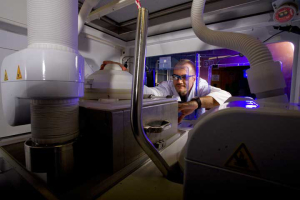Researchers at the UH Cullen College of Engineering have synthesized and characterized a novel metallic monolayer catalyst with far superior catalytic properties than those currently used in industry.
Stanko Brankovic, professor of electrical and computer engineering, and Lars Grabow, professor of chemical and biomolecular engineering, published their findings in a special issue of the journal Surface Science. Out of the over 25 papers chosen for publication in the special issue, Brankovic and Grabow’s paper, titled “Novel 2D RuPt core-edge nanocluster catalyst for CO electro-oxidation,” was chosen as the journal’s featured cover story.
Brankovic said this research began about a year ago with a seemingly innocuous idea: “I got some kind of idea to create a small, two-dimensional monolayer made up of clusters of one metal, such as ruthenium, with a perimeter made up of another metal, such as platinum.” After some trial and error, Brankovic and his Ph.D. student, Qiuyi Yuan, successfully synthesized these tiny nanostructures inside of his laboratory.
“But what was truly remarkable,” he said, “was their catalytic properties were way better than anything we could explain.”
It didn’t take long for Brankovic to mention the puzzling phenomenon to Grabow, whose primary research interest is in running complex computer simulations to predict how and why some catalysts perform better than others in certain chemical reactions.
“Lars had a hunch that the reason this material performs so well as a catalyst is due to the finite size effect,” Brankovic said.
The finite size effect relates to the bonds that form between atoms in a cluster. In a body of atoms, the atoms in the center of the cluster form strong bonds with the surrounding atoms. Atoms located on the periphery of the cluster, however, form weaker bonds because there are no atoms on the other side to keep them in equilibrium.
Grabow, along with his graduate student Hieu Doan, began running computer simulations to try to identify structures that could obtain extremely favorable catalytic properties due to the finite size effect. Using theoretical calculations to test their hypothesis, Grabow and Doan confirmed that the finite size effect contributed to the materials’ catalytic qualities.
“They found that the finite size effect in this particular system is huge and leads to reconstruction of the whole cluster, where the morphology of the monolayer has ripples,” Brankovic said.
The unique ripples in this system have positions for higher energy absorption and lower energy absorption, Brankovic added. “This leads to a net spectacularly high catalytic effect, so the finite size effect in particular systems such as this one can promote catalytic properties that until now have not been understood.”
After characterizing precisely what was happening inside of the metallic catalyst, Brankovic, Grabow, Yuan and Doan tested the material in carbon monoxide oxidation. The team used spectroscopy to measure the absorption energetics in the reaction.
“It turned out that everything Lars and Hieu had calculated was reconfirmed in these tests,” Brankovic said.
In addition to discovering a new method of synthesizing monolayer metallic catalysts, Brankovic and Grabow noted that this research represents a turning point for monolayer catalysis in general.
“Many catalysts can do the job, but chemical reactions can go many different pathways,” Brankovic said. “This particular structure of catalyst takes a pathway in the chemical reaction that has the most desired outcome, with better activity and selectivity.”
Although the researchers noted that more fundamental research is needed in this area, they hope that in the future these catalysts can be used for methanol or ethanol fuel cells as well as synthetic oxidation, such as the conversion of natural gas to methanol.
Both Brankovic and Grabow are winners of prestigious National Science Foundation CAREER Awards, which helped partially to fund this research. Funding for this work also came in the form of a University of Houston GEAR Award for both researchers, which offers seed funding to young researchers looking to get projects inside their laboratory off the ground.
“There’s a lot left to do in this area, and we hope to continue working on this. Our ultimate hope is to attract more funding to continue this work,” Brankovic said.
To access the full article, please visit here.
